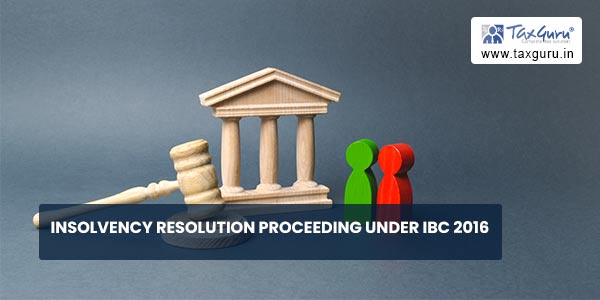> The Insolvency And Bankruptcy Code 2016 provides a consolidated time-bound process to resolve insolvencies, previously which was a lengthy process. The Code outlines separate insolvency resolution processes for individuals, companies and partnership firms.
> The code aims to protect the interests of small investors and make the process of doing business less cumbersome. The IBC process may be initiated by either the debtor or the creditors.
HISTORY
> Insolvency and Bankruptcy Code (IBC) 2016 was implemented through an act of Parliament. It got Presidential assent in May 2016.
> The Insolvency and Bankruptcy Code, 2016 has comes into effect after combining the provisions contained in various laws-
- Sick Industrial Companies Act, 1985.
- The Recovery of Debts Due to Banks and Financial Institutions Act, 1993.
- The Securitization and Reconstruction of Financial Assets and Enforcement of Security Interest Act, 2002.
- The Companies Act, 2013.
CONTENTS OF IBC 2016
INSOLVENCY AND BANKRUPTCY CODE, 2016 IS DIVIDED INTO FIVE PARTS:
I. Preliminary
II. Insolvency Resolution and Liquidation for Corporate Persons
III. Insolvency Resolution and Bankruptcy for Individuals and Partnership Firms
IV. Regulation of Insolvency Professionals, Agencies and Information Utilities
V. Miscellaneous
> It contains 255 Sections and
> Twelve Schedule
APPLICABILITY OF IBC 2016
THIS CODE SHALL APPLY TO:-
> Company incorporated under Companies Act, 2013 or any other previous law.
> Any other companies governed by any Special Act.
> Any other body corporate incorporated under any law for the time being force, as notified by the CG.
> Limited liability partnership (LLP) incorporated under Limited liability partnership 2008.
> Personal Guarantors to Corporate Debtors.
> Partnership firms and proprietorship firms.
> Individuals.
CORPORATE INSOLVENCY RESOLUTION PROCESS
WHO CAN INITIATE CIRP
Section 7- CIRP by Financial Creditor
Financial Creditor: any person to whom a financial debt is owed and includes a person to whom such debt has been legally assigned or transferred.
Section 8 & 9- CIRP By Operational Creditor
Operational Creditor: any person to whom an operational debt is owed and includes any person to whom such debt has been legally assigned or transferred.
Section- 10 CIRP by Corporate Applicant
Corporate applicant:
- Corporate Debtor (CD)
- Member or partner of corporate debtor
- Individual in charge of managing CD
- Person who has a control over CD
Corporate Debtor: means a corporate person who owes a debt to any person
FINANCIAL DEBT: means a debt along with interest which is disbursed against the consideration for the time value of money and includes:
> Money borrowed against the payment of interest
>Any amount raised by acceptance of credit facility or its dematerialised equivalent,
>Any amount raised pursuant to any note purchase facility or the issue of bonds, notes, debentures, loan stock or any similar instrument,
Receivables sold or discounted other than any receivables sold on non-recourse basis,

> Any amount raised under any other transaction, including any forward sale or purchase agreement, having the commercial effect of a borrowing,
Explanation. -For the purposes of this, –
(i) any amount raised from an allottees under a real estate project shall be deemed to be an amount having the commercial effect of a borrowing; and
(ii) the expressions, allottees and real estate project shall have the meanings respectively assigned to them in section 2 of the Real Estate (Regulation and Development) Act, 2016
> Any derivative transaction entered into in connection with protection against or benefit from fluctuation in any rate or price and for calculating the value of any derivative transaction, only the market value of such transaction shall be taken into account;
> Any counter-indemnity obligation in respect of a guarantee, indemnity, bond, documentary letter of credit or any other instrument issued by a bank or financial institution;
(Note: The amount of any liability in respect of any of the guarantee or indemnity for any of the items referred to in above clauses.)
SECTION 7 CORPORATE INSOLVENCY RESOLUTION PROCESS BY FINANCIAL CREDITOR
Financial creditor shall make an application either by itself or jointly with other financial creditors to the adjudicating authority (NCLT) for initiating insolvency resolution process.
[Note: an application for initiation corporate insolvency resolution process against the corporate debtor shall be filed jointly by not less than one hundred of such creditors in the same class or not less than 10% of the total number of such creditors in the same class, whichever is less]
INFORMATION TO BE PROVIDED ALONG WITH APPLICATION:
i. Record of the default recorded with information utility or any other record or evidence of default,
ii. Name of the proposed resolution professional to act as an interim resolution professional,
iii. Any other information as may be specified by the Board.
The NCLT shall within 14 days of receipt of application, either accept or reject the application filed by financial creditor.
ADMISSION OF APPLICATION– If the National Company Law Tribunal is satisfied that the existence of the default and application is complete and no disciplinary proceedings are pending against the proposed resolution professional, it shall admit the application
REJECTION OF APPLICATION– if the National Company Law Tribunal finds that the default has not occurred or the application is incomplete or any disciplinary proceeding is pending against the proposed resolution professional, it may reject the application.
A notice shall be given for rectification of defect in the application within 7 days from the receipt of application
Communication of order: The NCLT shall communicate, within 7 days of admission or rejection of such application,
i. to the financial creditor and the corporate debtor where the application is accepted,
ii. to the financial creditor where the application is rejected
⇓
COMMENCEMENT OF INSOLVENCY RESOLUTION PROCESS; the corporate insolvency resolution process shall commence on admission of the application.
SECTION 8 INSOLVENCY BY OPERATIONAL CREDITOR
A Demand notice or a copy of invoice demanding repayment shall be given to the corporate debtor, on occurrence of default
Corporate debtor shall within 10 days of receipt of demand notice or invoice, inform to the operational creditor of the existence of a dispute debt claimed or the payment of the debt by sending;
- An attested copy of the record of electronic transfer of the unpaid amount from the bank account of the corporate debtor, or
- An attested copy of record that the operational creditor has encashed a cheque issued by the corporate debtor.
SECTION 9 APPLICATION FOR INTIMATION INSOLVENCY RESOLUTION PROCESS BY OPERATIONAL CREDITOR
In case operational creditor does not receive any payment or notice of dispute from corporate debtor within 10 days of delivery of notice, operational creditor shall make an application with the NCLT for initiating insolvency resolution process
APPLICATION SHALL ACCOMPANIED WITH;
> Copy of demand notice or invoice
> An affidavit to the effect that no notice given by the corporate debtor relating to unpaid operational debt,
> A copy of the certificate from the financial institutions maintaining accounts of the operational creditor confirming that there is no payment of an unpaid operational debt.
> A copy of any record with information utility confirming that there is no payment of an unpaid operational debt by the corporate debtor,
> Any other proof confirming that there is no payment of debt by the corporate debtor.
GROUNDS FOR REJECTION OF APPLICATION
- Application is incomplete
- Payment has been made to the operational creditor
- Creditor has not delivered Invoice or notice for payment to corporate debtor
- Disciplinary proceeding is pending against proposed resolution professional
↓
COMMENCEMENT OF INSOLVENCY RESOLUTION PROCESS; the corporate insolvency resolution process shall commence on admission of the application.
SECTION 10 INSOLVENCY RESOLUTION BY CORPORATE APPLICANT
↓
APPLICATION: A corporate applicant may file an application with NCLT for initiating resolution process
DOCUMENTS TO BE FURNISHED ALONG WITH APPLICATION;
> Books of account and other document,
> Information about proposed interim resolution professional.
> Copy of special resolution passed by the shareholders or resolution approved by ¾ of total no. of partner of corporate debtor.
A notice shall be given for rectification of defect in the application within 7 days from the receipt of application.
Admission of application– If the National Company Law Tribunal is satisfied that the existence of the default and application is complete and no disciplinary proceedings are pending against the proposed resolution professional, it shall admit the application.
↓
COMMENCEMENT OF INSOLVENCY RESOLUTION PROCESS; the corporate insolvency resolution process shall commence on admission of the application.





